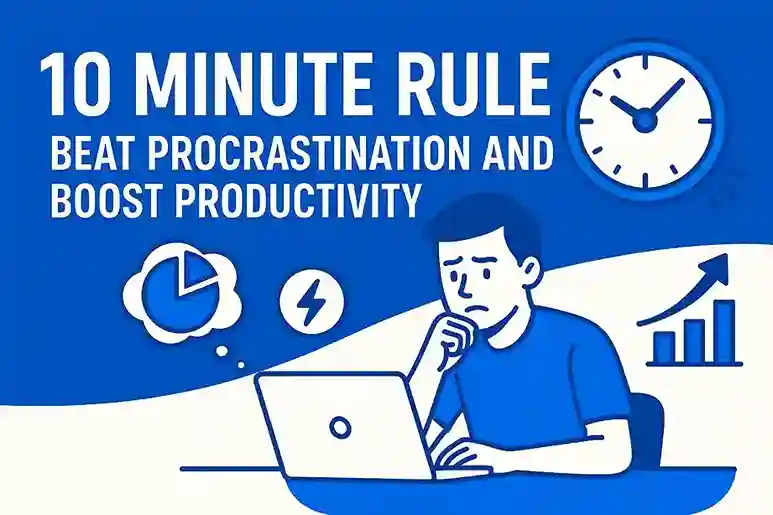

What if just 10 minutes could transform your productivity?
In today’s fast-paced world, procrastination is a common challenge. According to a survey of 2219 persons performed by Darius Foroux, 88% of workers admit to procrastinating for at least an hour daily. Not just that, a staggering 50% of college students engage in chronic procrastination and 75% identify themselves as procrastinators . This widespread issue affects not only students but also professionals, creatives, and entrepreneurs, leading to decreased productivity and increased stress.
Enter the 10 Minute Rule, a simple yet powerful technique that encourages you to commit to a task for just ten minutes. This approach helps overcome the initial resistance to starting a task, making it easier to build momentum and maintain focus. Whether you’re tackling a daunting project or a mundane chore, dedicating a mere ten minutes can make a significant difference in your productivity and mental well-being.
In this blog, we’ll explore the origins of the 10 Minute Rule Steve Jobs , its psychological underpinnings, and practical strategies to incorporate it into your daily routine. Discover how this method can help you beat procrastination and boost your productivity, one manageable step at a time.
The 10 Minute Rule is a simple yet effective productivity technique designed to help you overcome procrastination. It works like this: when you’re dreading a task, commit to doing it for just 10 minutes, no more. If you still want to stop after that, you can. But most often, once you start, the resistance fades, and you keep going.
This method tricks your brain into action by lowering the barrier to entry. It’s especially helpful for tasks that feel overwhelming or boring. Used by students, professionals, and creatives alike, the Ten Minute Rule makes starting easier, and starting is half the battle.
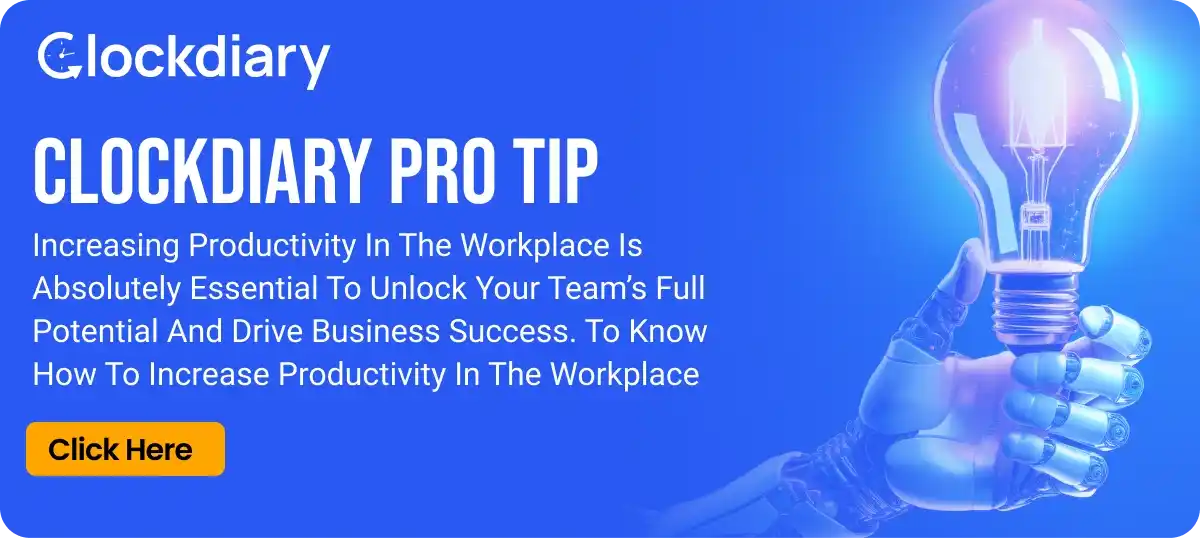
The 10 Minute Rule psychology isn’t just a productivity hack. It’s rooted in powerful psychological principles that make it remarkably effective across different age groups and professions. Here’s why it works:
When you’re faced with a task you dread, your brain perceives it as a threat, triggering stress and avoidance. The 10 Minute Rule lowers that emotional barrier by making the task feel more manageable.
Telling yourself “just 10 minutes” reduces the fear of failure or overwhelm, helping you start the hardest part.
Once you begin, inertia shifts. According to Newton’s First Law, objects in motion stay in motion and so do people. That small start builds momentum. What began as a short session often extends into sustained productivity.
Procrastination and anxiety are tightly linked. A study in the British Journal of Health Psychology found that even short periods of mindfulness can ease depression and anxiety, making tasks feel more manageable.
Tackling a small part of a task for 10 minutes helps reduce the looming stress of unfinished work. It also provides a sense of control, calming your nervous system and helping you feel more in charge of your time.
Setting a 10-minute timer narrows your attention span. You’re not committing to the entire project. Just a slice of it. That tight focus acts like a mental sprint, helping your brain tune out distractions and zero in on what matters. Alternatively, you can consider working in flex schedules for enhanced productivity.
Completing even a small chunk of a task gives your brain a dopamine boost. That hit of satisfaction encourages you to continue, reinforcing a productive mindset.
Psychologist Mihály Csíkszentmihályi describes flow as complete absorption in an activity, leading to enjoyment and enhanced performance.
After getting started, you often slip into a “flow” state, where time seems to disappear, and work feels effortless. The 10 Minute Rule is the gateway to this deeply focused and fulfilling zone. Studies have shown that people in flow states can be up to 500% more productive.
Short, intentional bursts of work improve cognitive retention. Consistent 10-minute sessions help encode information more effectively, especially for learners and creatives.
So, we can safely say that the Ten Minute Rule isn’t just easy. It’s scientifically smart. Here’s a bar graph showing the psychological benefits of the 10 Minute Rule and their contribution to productivity.
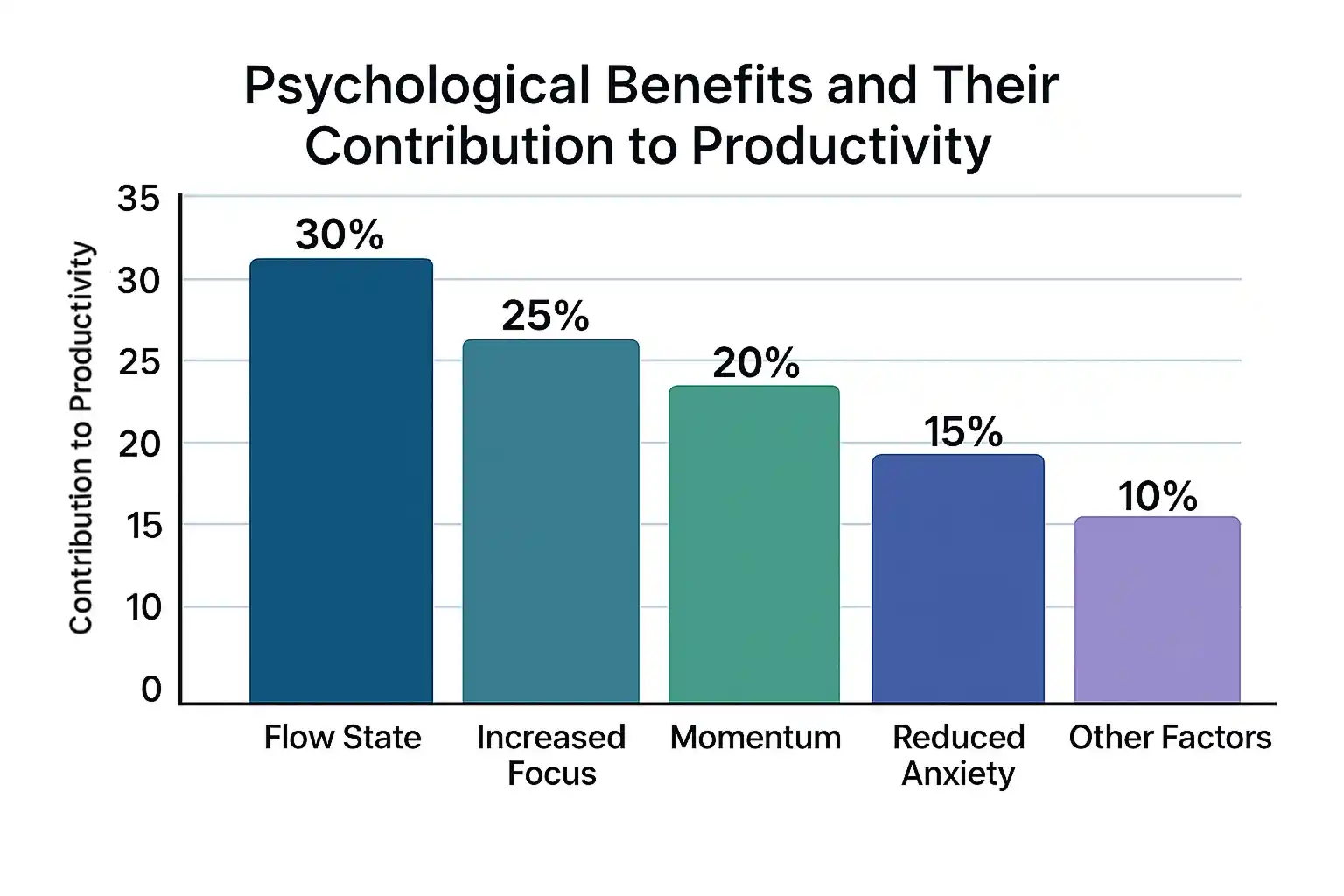
The 10 Minute Rule is a universal tool that can empower people from all walks of life. Whether you’re managing multiple projects with competing deadlines, struggling with motivation, or just trying to build better habits, this technique offers a simple path forward. Here’s who benefits most:
From cramming for exams to writing research papers, students often battle overwhelm. Procrastination is prevalent among students, with studies indicating that 80% to 95% of college students delay tasks, particularly coursework (according to American Psychological Association). This is where 10 minute rule college steps in.
10 Minute Rule for learning helps break large tasks into manageable pieces, reducing academic stress and improving study consistency.
It’s especially helpful for those with ADHD or executive function challenges.
Corporate employees, remote workers, and freelancers face constant demands and distractions. Using the Ten Minute Rule can cut through task paralysis and help professionals make steady progress on complex multiple projects with competing deadlines, emails, or presentations, even when motivation is low.
Writers, artists, designers, and musicians often wait for “inspiration” to strike. But the act of starting, even for just 10 minutes, can ignite creative flow. This rule makes it easier to push through creative blocks and develop a consistent practice.
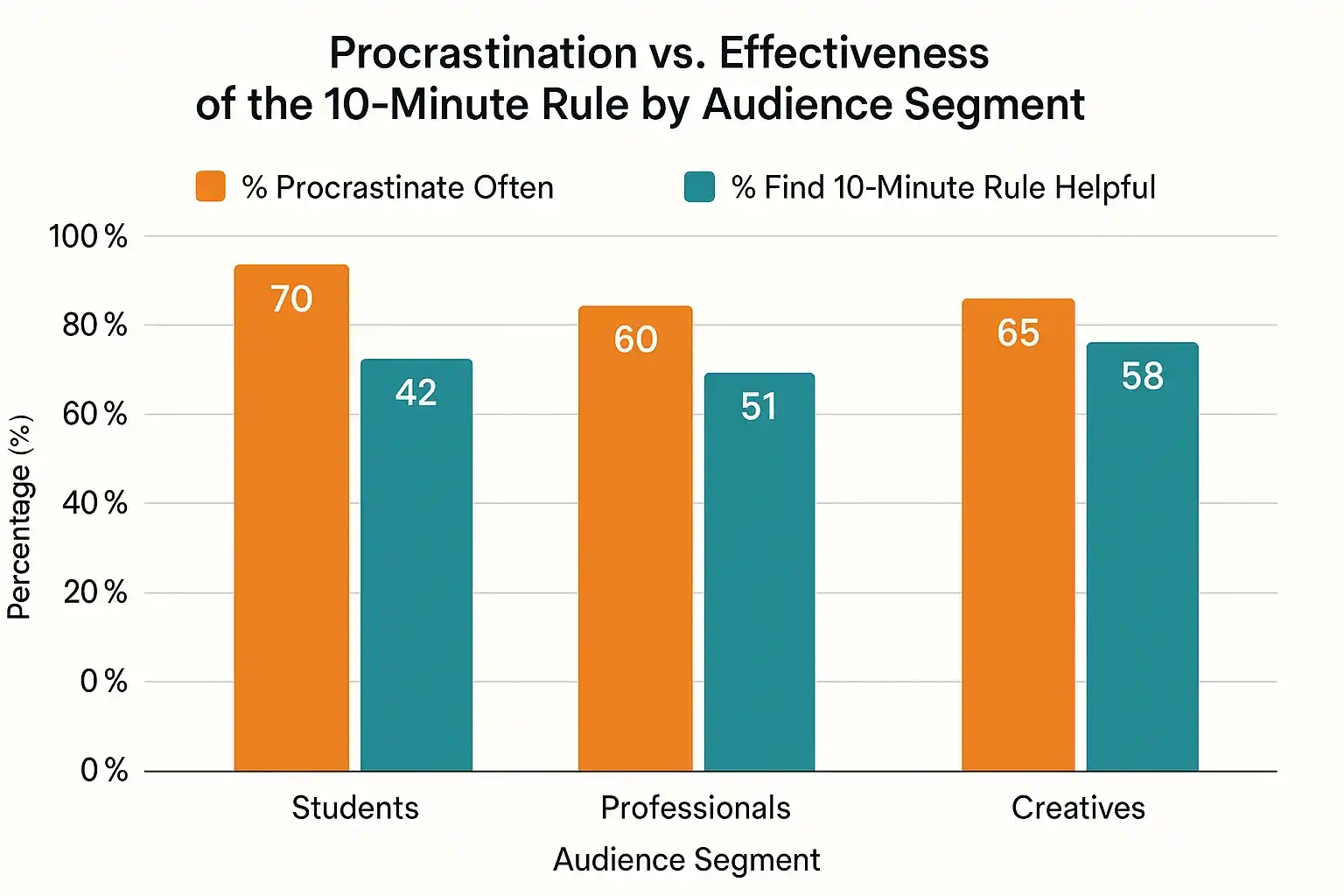
Running a business means wearing many hats. Approximately 76% of entrepreneurs spend 1 to 4 hours procrastinating daily.
Entrepreneurs can use the Steve Jobs 10 Minute Rule to tackle administrative tasks, brainstorm ideas, or develop content, without feeling overwhelmed by the size of their to-do list.
Chronic procrastination affects about 20% of adults. If you constantly put things off, this rule is your entry point to action. It lowers mental resistance, helps reduce guilt, and makes it easier to form productive habits.
Can’t commit to an hour at the gym or 30 minutes of meditation? A survey found that nearly 70% of people want to improve their health but are deterred by the magnitude of changes required.
Start with 10 in minutes. Whether it’s a quick stretch, journaling, or meal prep, small actions lead to big lifestyle shifts.
Short, focused sessions, like reading or language practice, help reinforce learning and retention, making the 10 Minute Rule a valuable cognitive tool.
So, you see, incorporating the 10 Minute Rule Steve Jobs into daily routines can provide significant benefits across various aspects of life, from academic and professional performance to personal health and cognitive function.
Implementing the 10 Minute Rule effectively is about building momentum with small, intentional steps. Here’s how to put it into action for real, lasting results:
Start by picking one specific task you’ve been avoiding, something you know you need to do but keep putting off. This could be writing a report, cleaning your inbox, going for a walk, or studying for an exam. Choose a task that feels important but mentally “heavy.” A good task management software can come in handy here.
Commit to working on that task for just 10 minutes. Use a physical clock 10 min, your phone, or a time-tracking app like Clockdiary. Setting a timer creates a psychological boundary that makes the task feel finite and less intimidating.
Begin right away, no overthinking. Even if you don’t feel motivated, just take the first small step. The goal isn’t to finish the task in 10 minutes, but to simply begin. Action breeds momentum, and often you’ll find yourself continuing well beyond the timer.
When the timer goes off, pause and check in with yourself. Ask: Do I want to keep going? If you feel in the zone, ride that wave. If not, give yourself permission to stop without guilt. You’ve already won by starting. Good goal tracking apps can be your best bet in this context.
Research indicates that self-reflection can lead to a 22.8% increase in productivity.
The power of the 10-Minute Rule lies in repetition. Use it daily to chip away at long-term goals or form new habits. Over time, it rewires your brain to approach tasks with less resistance and more confidence.
After all, habit formation is key to sustained productivity, and studies suggest that it takes approximately 66 days to form a new habit.
By consistently applying Steve Jobs’ 10 Minute Rule, tasks become more manageable, and the cycle of procrastination can be broken. This method leverages psychological principles to promote discipline and enhance focus, making it a valuable tool for students, professionals, and anyone seeking to improve their productivity.
To get the most out of the 10 Minute Rule, it helps to approach it with intention and strategy. These practical tips will help you maximize its effectiveness and turn it into a sustainable habit:
Use a 10 minute time clock to create a clear start and stop point. For those 10 minutes, eliminate distractions—put your phone on silent, close extra tabs, and commit fully to the task. Treat it like a mini sprint. Even if it’s short, focused time blocking beats unfocused effort.
Large tasks can still feel overwhelming, even in 10 10 minutes chunks. Break them into smaller, actionable steps. This approach aligns with the principles of the Getting Things Done method by David Allen, which emphasizes breaking tasks into actionable steps to reduce overwhelm and increase efficiency.
For example, instead of “write a report,” start with “outline the introduction.” This helps reduce friction and boosts clarity on what to do next.
After each 10-minute session, pause to recognize what you accomplished. Progress, no matter how small, reinforces motivation. Momentum builds when you acknowledge that showing up is a win.
Keep a simple log. Check off completed sessions or journal a quick note. Chris Bailey, in his book “The Productivity Project,” recommends keeping a “done” list to boost motivation and provide a sense of accomplishment.
Visibly tracking progress helps you stay motivated and gives you proof of your efforts. Celebrate small wins with a quick stretch, music break, or a favorite snack.
Anchor the rule to daily habits, a technique known as habit stacking. For instance, do a 10-minute task right after morning coffee or before your lunch break. Use a habit tracker app for better results. This pairing builds consistency and reduces the effort needed to get started.
Follow intense 10-minute bursts with short, intentional breaks. It refreshes your mind and prevents burnout, especially during longer work periods.
If the timer ends and you’re still not in the groove, it’s okay to stop. The goal is consistency, not perfection. The key is: you showed up. That’s where real growth begins.
By implementing these strategies, you can enhance the effectiveness of the 10 Minute Rule procrastination, making it a more powerful tool in your productivity arsenal.
While the 10 Minute Rule is simple and effective, it’s not foolproof. To truly benefit from it, you’ll want to steer clear of some common mistakes that can undermine your efforts:
Expecting to complete an entire project in 10 minutes sets you up for disappointment. The rule is meant to start momentum, not finish everything. Keep your goals realistic and focused on progress, not perfection. Effective time management strategies can prove to be a boon here.
If the task feels meaningless or disconnected from your goals, even 10 minutes can feel like a drag. Take a moment to reflect on why the task matters, whether it aligns with your personal growth, career goals, or well-being.
Don’t treat 10-minute sessions as isolated moments. Look at how each session fits into the bigger picture. This helps build continuity and keeps your long-term goals top of mind, boosting motivation.
Forcing yourself to grind for 10 minutes especially when you’re burned out due to managing multiple projects can backfire. The rule should lower resistance, not create more stress. Choose tasks wisely, and adjust based on your energy levels to avoid mental fatigue or disengagement.
If you’re writing, editing, or preparing content during your 10-minute sessions, rushing can lead to careless errors. Give yourself permission to draft without editing, then revisit with a fresh eye later.
Don’t squeeze 10-minute tasks into already-packed schedules. Give them their own dedicated time. Strategically placing them before or after routine tasks can help make them stick.
Avoid using your 10 minute block to discuss the task with others unless it’s essential. Too much talking can eat up your precious window of focus. Instead, channel that time into action.
Avoiding these pitfalls helps you turn the 10 Minute Rule into a powerful productivity ally.
The 10 Minute Rule is a popular strategy for tackling procrastination and boosting productivity. But like any technique, it comes with its strengths and limitations. Here’s a balanced look at the pros and cons:
Here are some of the pros of the 10-Minute Rule:
The biggest strength of the Ten Minute Rule procrastination is that it helps you overcome procrastination and gets you moving. Starting a task is often the hardest part, and committing to just 10 minutes reduces the psychological barrier.
This approach aligns with the Zeigarnik Effect, which suggests that people remember uncompleted tasks better, motivating them to finish what they’ve started.
Once you begin, it’s easier to continue. That initial push often leads to longer periods of productivity, especially when you realize the task isn’t as daunting as it seemed.
Breaking a big task into small time frames makes it feel manageable. It helps you stay calm and focused instead of getting stuck in analysis paralysis.
Short bursts of time encourage deep focus. Knowing that you only have 10 minutes left keeps you present and minimizes the temptation to multitask.
The rule can be applied to almost any area—work, health, creativity, or personal growth. It’s easy to customize for different goals and energy levels. Not just that, it helps improve work life balance, indirectly, if not directly.
Having a clear, short time frame discourages distractions. You’re more likely to silence your phone, close social media, and stay locked in.
Now, let’s take a look at the cone of the 10 Minute Rule:
Some tasks require more continuous, uninterrupted time, such as deep research, coding, or strategy planning. About 10 minutes may not be enough to make meaningful progress.
While it’s great for starting, it may not help you complete complex projects unless paired with a larger time management system.
In shared or unpredictable environments, your 10-minute window may be interrupted, breaking focus and defeating the purpose.
While many find this rule helpful, some people need longer sessions to truly engage. Others may use it as an excuse to underperform if not self-aware.
Used wisely, the Ten Minute Rule is a powerful tool. But it works best when combined with thoughtful planning and a realistic understanding of your task.
The 10 Minute Rule isn’t just a theory. It’s a practical, real-world tool used by students, professionals, creatives, and parents alike. Here’s how it plays out in everyday life:
Thus, we can say that the 10-minute rule bears testament to the fact that if small efforts are consistently applied, it will certainly lead to fruitful results. Take a look at this donut chart showing how people apply the 10 Minute Rule across different domains of their life.

You can never achieve top-notch productivity with a one-size-fits-all approach. While the 10 minute rule is known to overcome procrastination, other techniques can come in more handy for different tasks or personalities.
Are you in a dilemma as to which productivity method you should choose or when the 10 minute rule can be your best bet? Here’s a detailed comparison to help you make an informed decision:
Here’s how Ten Minute Rule differs from Pomodoro Technique:
| Parameters | 10 Minute Rule | Pomodoro Technique |
| Session Length | 10 minutes | 25 minutes work + 5 minute break |
| Goal | Just get started | Maintain focused intervals |
| Best for | Procrastinators, Overwhelmed minds | Structured productivity sessions |
| Flexibility | Highly flexible | Requires time tracking |
| Breaks Required | Optional | Mandatory after each Pomodoro |
Here’s how Ten Minute Rule differs from Eat That Frog ( a type of Getting Things Done Method):
| Parameters | 10 Minute Rule | Eat That Frog |
| Main Focus | Starting with small effort | Tackling your hardest task first |
| Motivation Style | Ease into action | Face the biggest challenge head-on |
| Best for | Low motivation or energy | High-stakes, high-priority days |
| Approach | Gentle, progressive | Bold, direct |
Here’s how Ten Minute Rule Differs from Time Blocking:
| Parameters | 10 Minute Rule | Time Blocking |
| Scheduling | Ad-hoc or flexible | Pre-scheduled calendar blocks |
| Structure | Low structure | Highly structured |
| Best for | Spontaneous starters | Long-term planners |
| Focus Duration | Short bursts | Deep work sessions |
| Scenario | Best Method |
| Feeling unmotivated or overwhelmed | 10 Minute Rule |
| Need structured, deep work time | Pomodoro or Time Blocking |
| Big, important task looming | Eat That Frog |
| Easily distracted or Scattered | Pomodoro or 10 Minute Rule |
| Want flexibility and low stress | 10 Minute Rule |
Each method serves a purpose. The key is matching the right tool to your current mindset and task.
To help you turn the 10 Minute Rule into a consistent habit, we’ve created a free, easy-to-use 10-Minute Rule Tracker. This simple tool helps you stay accountable, visualize your progress, and build momentum, one small win at a time.
Our printable 10 Minute Rule tracker Google Sheets is perfect for those who love pen-and-paper planning. Designed to fit right on your desk, notebook, or vision board, it lets you mark off each completed 10-minute session with ease.
Whether you’re working on personal goals, academic tasks, or professional projects, this visual progress tracker keeps you motivated. Studies show that checking off small wins increases dopamine, the brain’s motivation chemical, making you more likely to keep going.
Included in the download are two formats:
Both templates are minimal, clean, and customizable, whether you want to color-code tasks or add motivational notes. You can print multiple copies or keep them in a digital format.
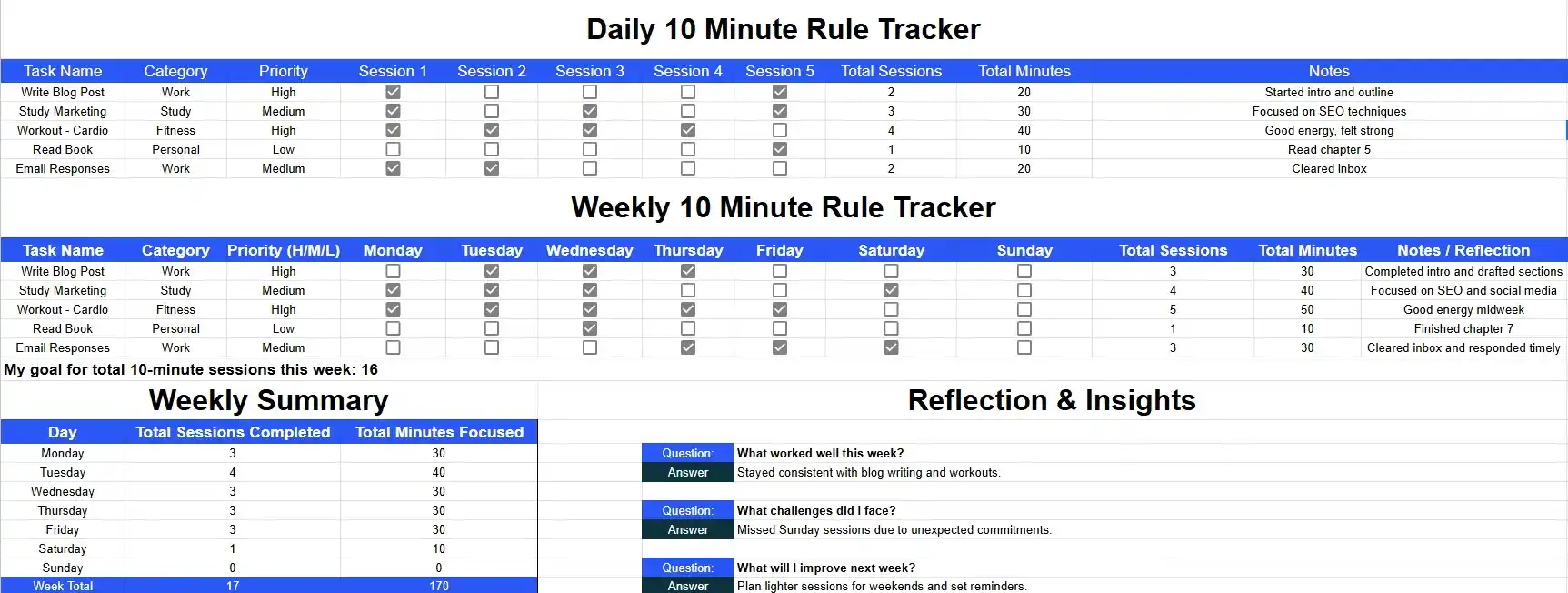
👉 Download your free 10 Minute Rule tracker now and take the first step toward better focus, less procrastination, and real progress, all in just 10 minutes a day. Whether you’re a student, entrepreneur, or personal growth enthusiast, this tool will keep you on track.
When it comes to beating procrastination and boosting productivity, Clockdiary stands out as a powerful, free time-tracking tool. Whether you’re a student, remote worker, entrepreneur, or creative, Clockdiary helps you stay focused, accountable, and intentional with your time.
Clockdiary’s core feature—AI-powered time tracking lets you start a timer with one click or log time manually. This encourages you to start now, which aligns perfectly with the 10 Minute Rule. Just starting a ten minute clock reduces hesitation and gives your task a clear beginning.
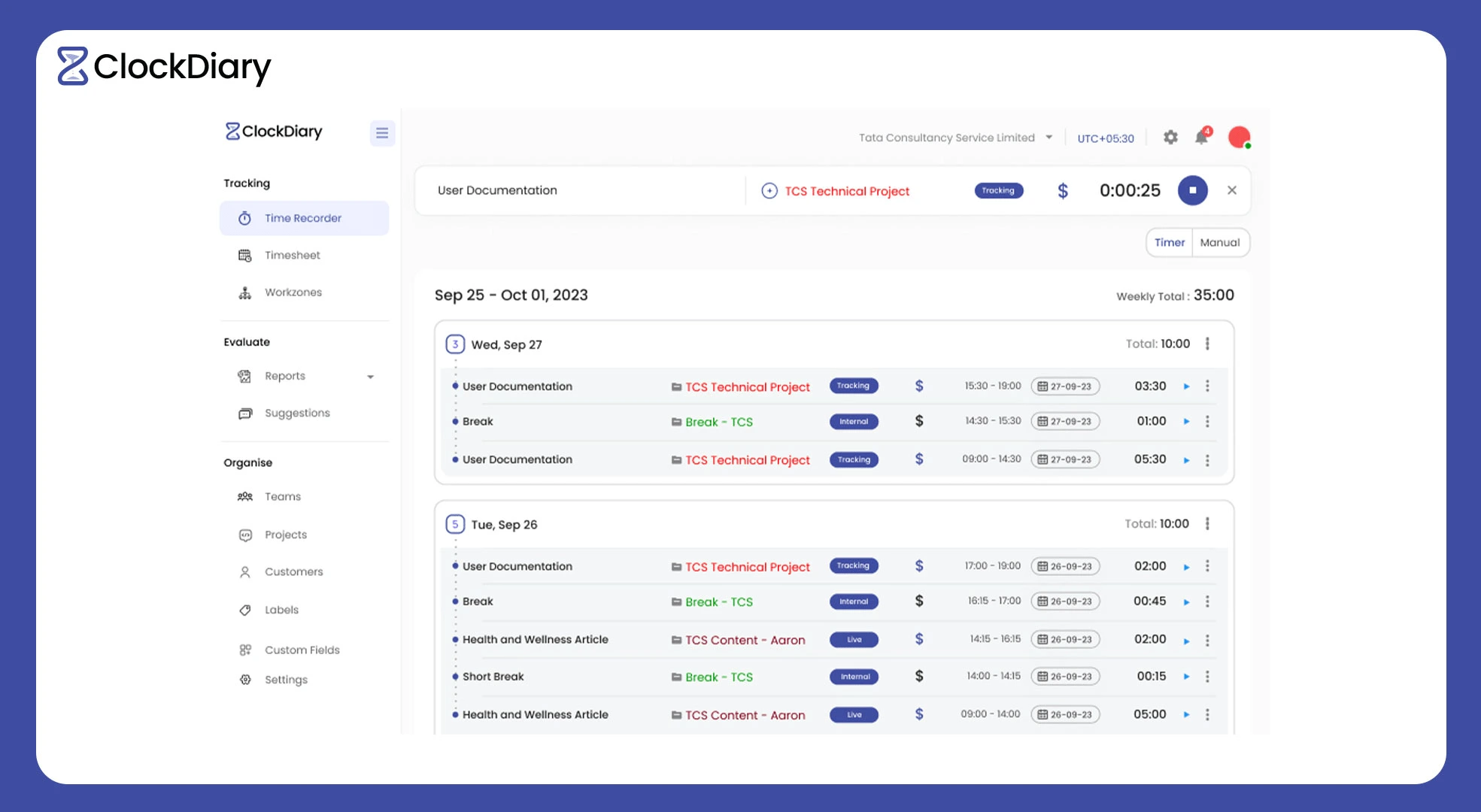
Clockdiary’s timesheet feature allows users to log weekly activities efficiently, categorizing time spent on various projects and tasks. This structured approach provides a clear overview of how time is allocated, enabling users to identify areas where productivity can be improved.
The timesheet view is particularly beneficial for those accustomed to manual time entry, offering a streamlined method to record work hours.
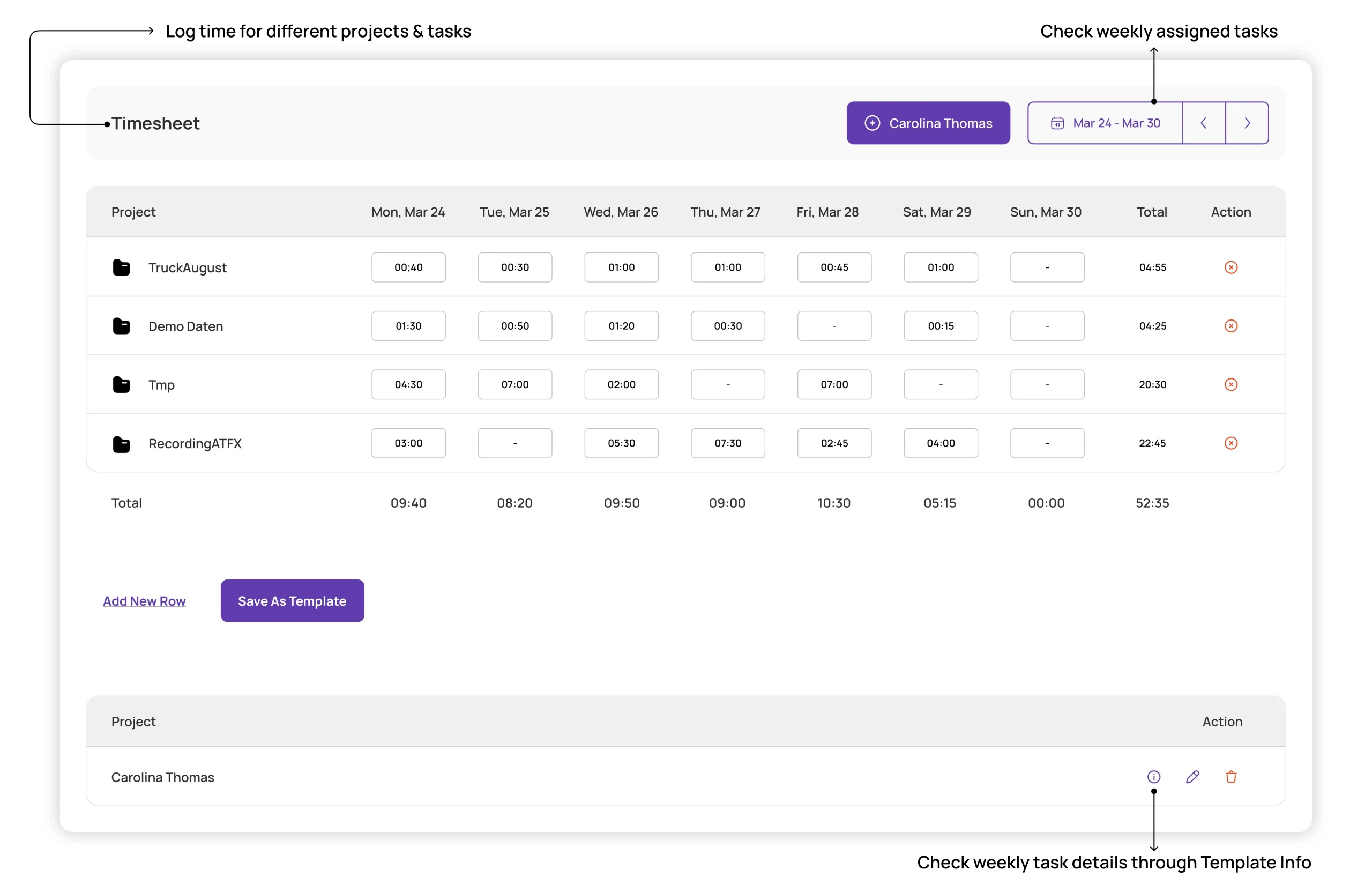
Its visual reports show how you’re spending your time daily, weekly, or monthly. This can highlight patterns of distraction or procrastination and help you course-correct. Seeing your productive hours adds a motivational boost, reinforcing consistency.
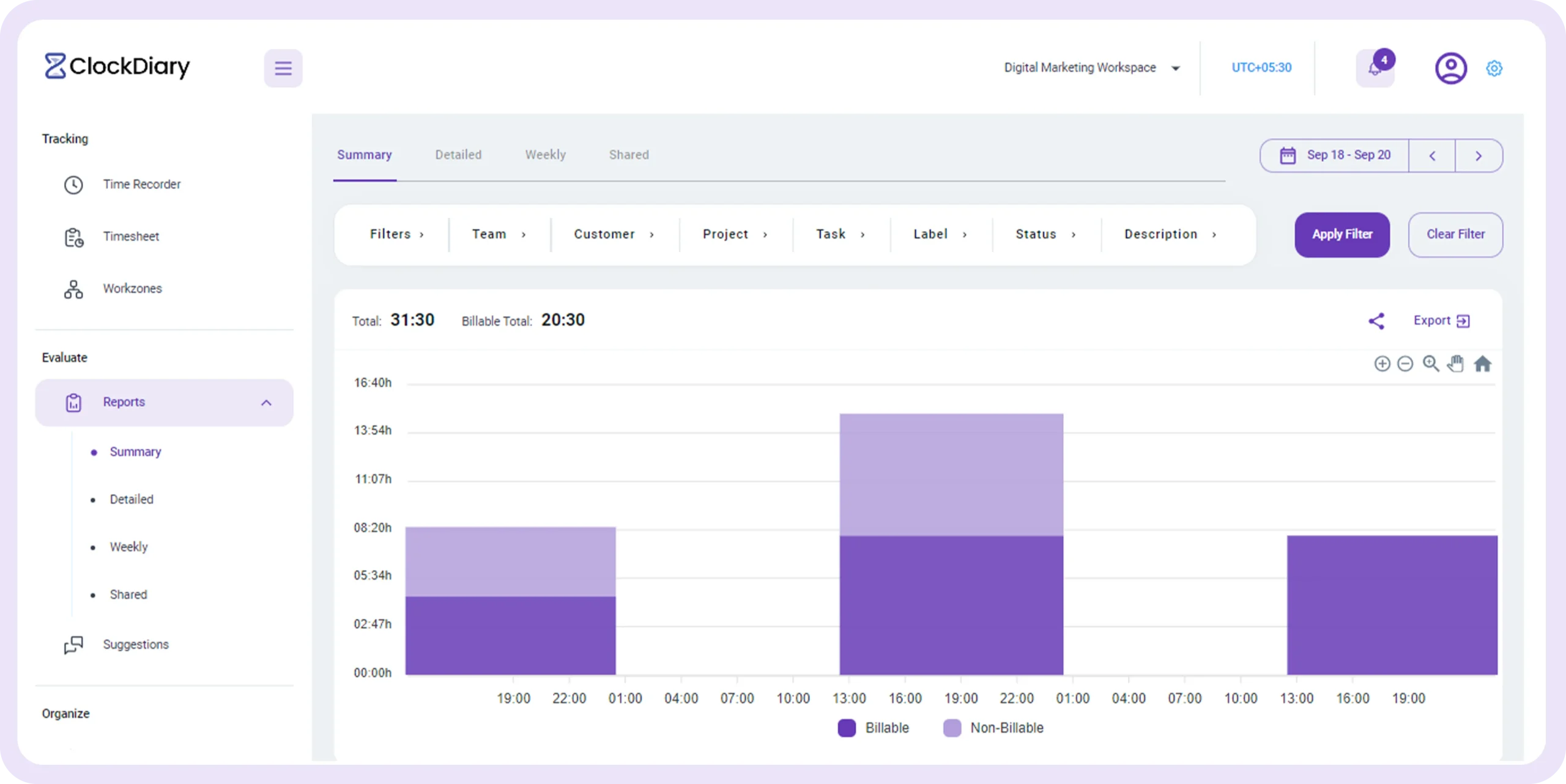
You can organize time entries by projects, clients, or tasks, making it easier to focus on what matters most. This feature is especially helpful for freelancers, teams, or anyone juggling multiple priorities.
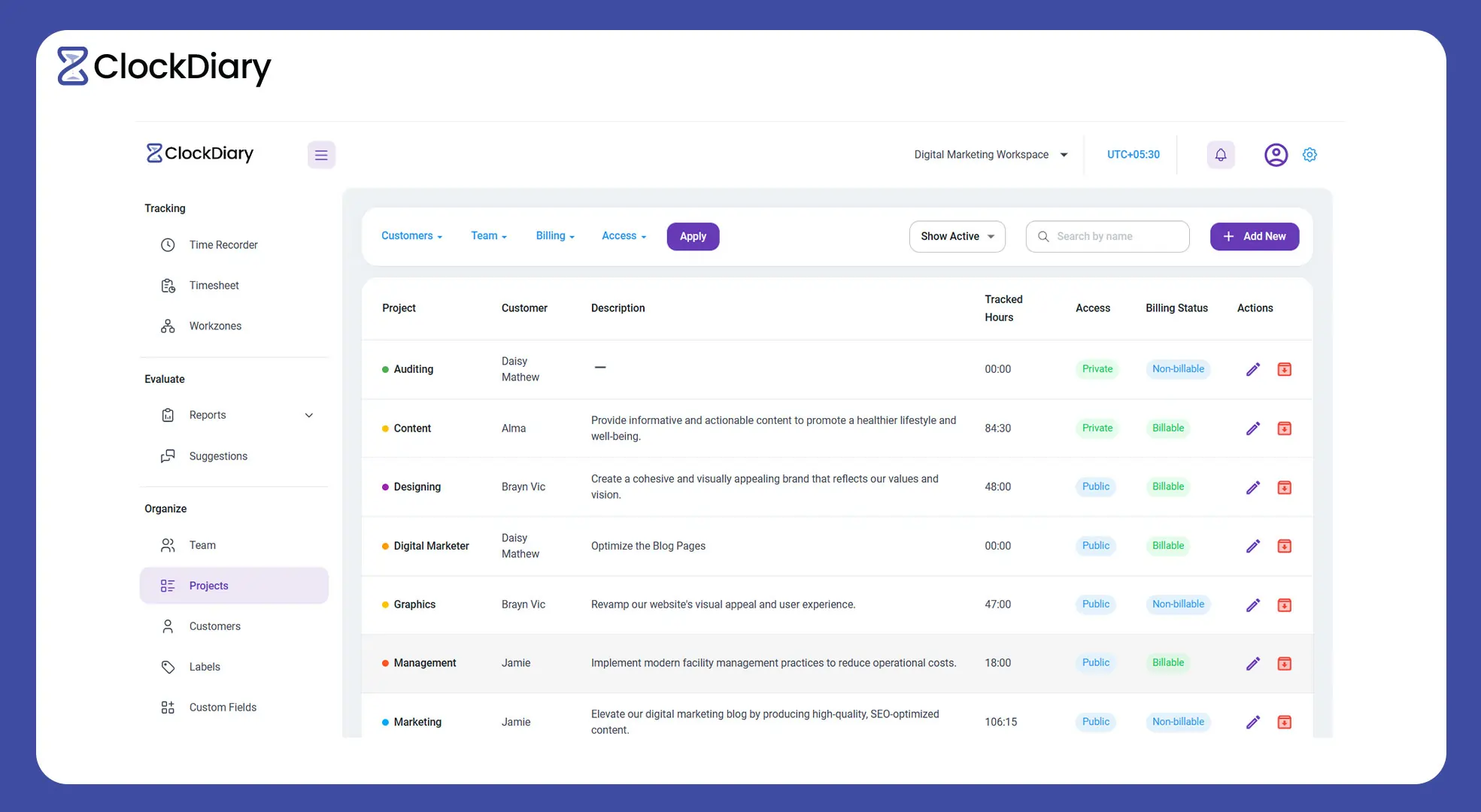
The Auto Tracker feature captures screenshots at regular intervals, thus recording the applications and websites used during work sessions. This passive tracking helps users identify unproductive behaviors, such as excessive time on social media, and make necessary adjustments to their routines.
By understanding where time is lost, users can implement changes to minimize distractions and enhance focus.

Clockdiary’s AI Rule Engine facilitates employee monitoring by analyzing how team members spend their time across tasks and projects. This feature helps managers identify productivity trends and make data-driven decisions to enhance team performance.
Clockdiary’s AI-powered features gently nudge you with reminders if you forget to start tracking, and detects idle time (thanks to the in-built activity tracker), prompting you to stay engaged. These features minimize time lost to distractions or unintentional breaks.
Available on web, desktop, mobile, and as a Chrome extension, Clockdiary fits seamlessly into your workflow, whether you’re working from your laptop or on the go.
Thus, we can say that Clockdiary makes time visible, intentional, and manageable—three essential ingredients for overcoming procrastination and boosting daily productivity. Get in touch with us to make this supremely engineered tool a part of your daily life and see the difference for yourself.
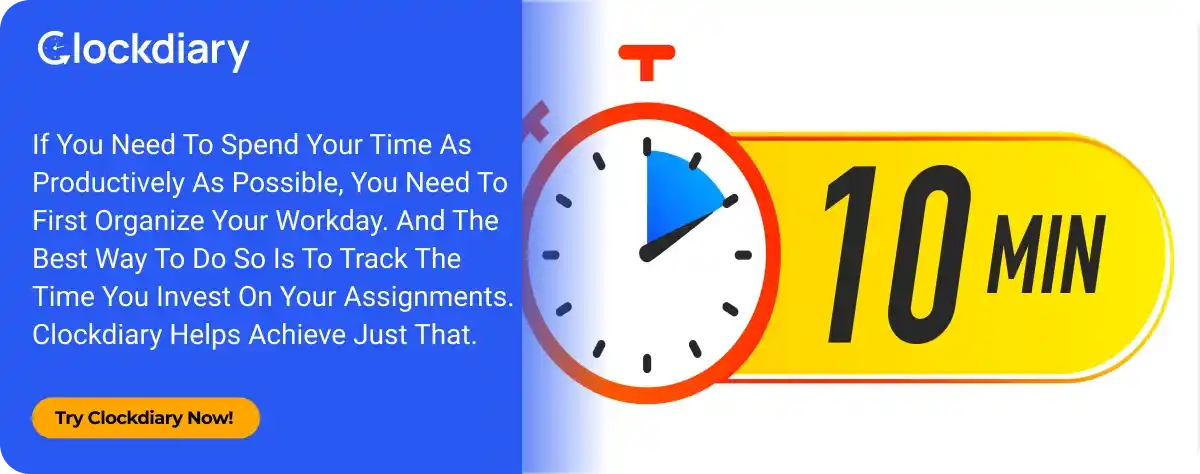
FAQs About The 10 Minute Rule
The 10 Minute Rule for ADHD is a productivity strategy that encourages individuals to commit to a task for 10 minutes, making it easier to overcome mental resistance and get started. It leverages short, low-pressure time frames to help improve focus, reduce overwhelm, and build momentum, especially helpful for those with executive function challenges.
The 10 Minute Rule in relationship encourages partners to spend at least 10 uninterrupted minutes each day fully focused on each other—talking, listening, or simply being present. This small, intentional act helps strengthen emotional connection, improve communication, and foster intimacy over time.
The 10 Minute Rule of Learning involves dedicating just 10 minutes at a time to focus on studying or practicing a skill, making it easier to start and maintain a consistent habit. This approach reduces cognitive overload, enhances retention, and leverages short bursts of concentration to build long-term knowledge effectively.
The 10 Minute Rule garlic refers to letting freshly chopped or crushed garlic sit for about 10 minutes before cooking it. This waiting period activates allicin, a powerful compound responsible for garlic’s health benefits and strong flavor, ensuring maximum potency in both nutrition and taste.
The 10 Minute Rule homework suggests that students should spend about 10 minutes per grade level on homework each night, for example, 30 minutes for a 3rd grader. This guideline helps balance academic workload with age-appropriate focus levels and prevents burnout, especially in younger learners.
The 10-Minute Rule for cooking fish is a general guideline that suggests cooking fish for 10 minutes per inch of thickness, measured at the thickest part. This method helps ensure the fish is cooked through without becoming dry, whether you’re baking, grilling, or broiling.
The 10 Minute Rule for puppies recommends limiting training or play sessions to about 10 minutes to match their short attention spans and prevent overstimulation. Keeping interactions brief and positive helps build good habits, reinforces learning, and strengthens the bond between you and your puppy.